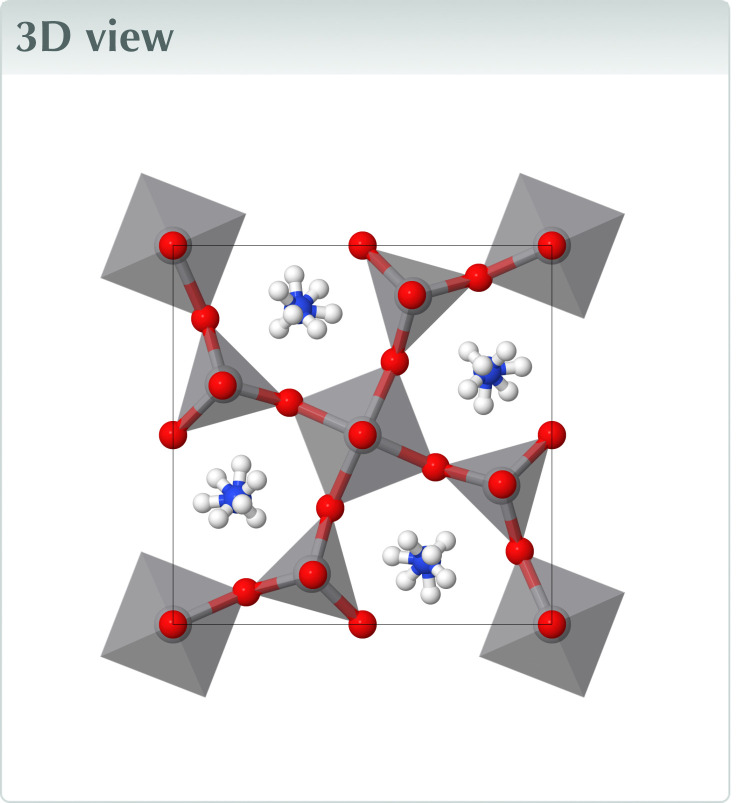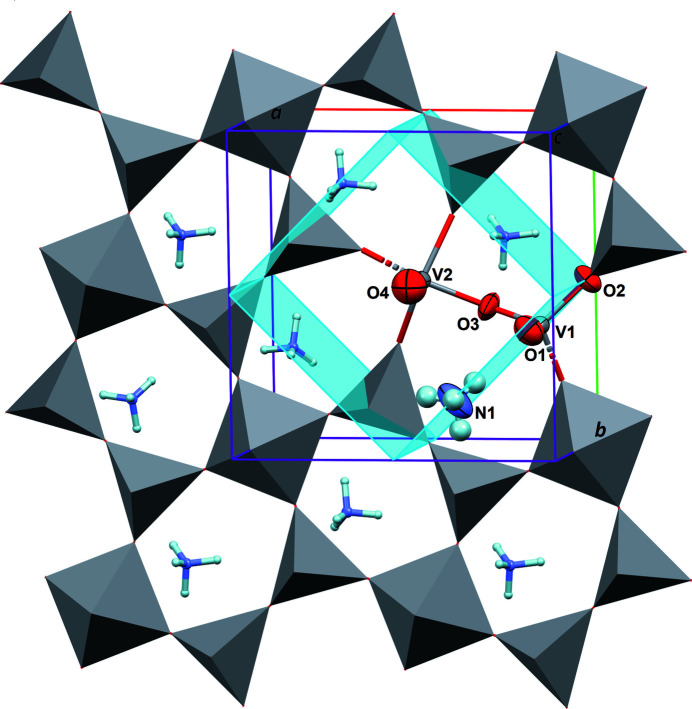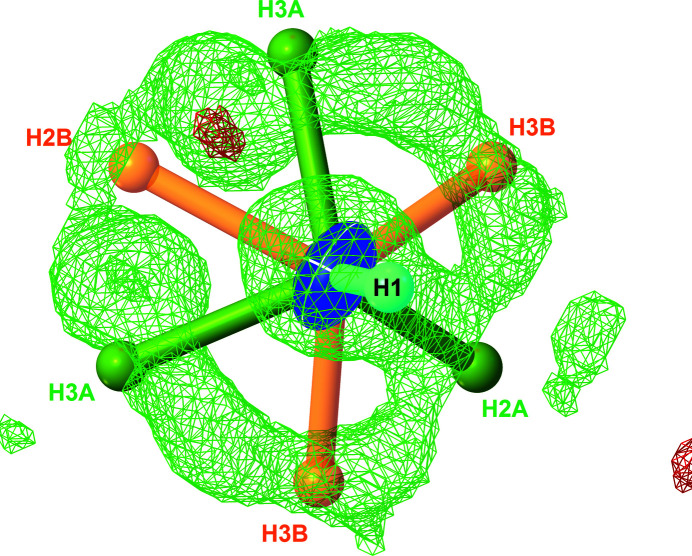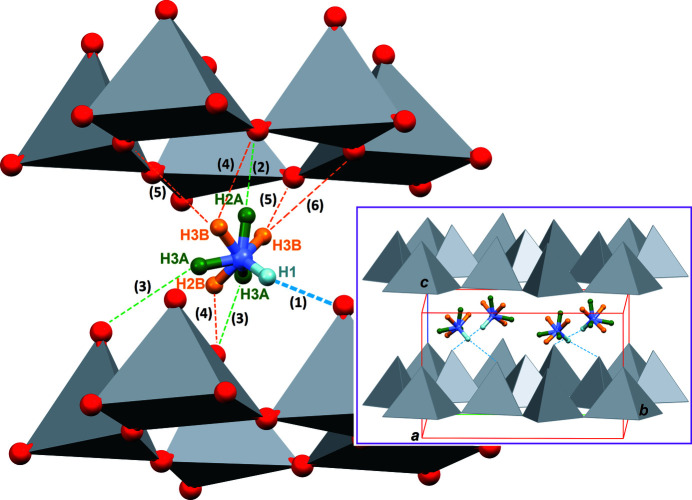The crystal structure of (NH4)2V3O8 has been redetermined using data collected at 0.61 Å resolution, showing that the ammonium cation is disordered by rotation around a non-crystallographic axis.
Keywords: crystal structure, vanadate, ammonium, high-resolution data, redetermination
Abstract
The crystal structure of (NH4)2V3O8 has been reported twice using single-crystal X-ray data [Theobald et al. (1984 ▸). J. Phys. Chem. Solids, 45, 581–587; Range et al. (1988 ▸). Z. Naturforsch. Teil B, 43, 309–317]. In both cases, the orientation of the ammonium cation in the asymmetric unit was poorly defined: in Theobald’s study, the shape and dimensions were constrained for NH4
+, while in Range’s study, H atoms were not included. In the present study, we collected a highly redundant data set for this ternary oxide, at 0.61 Å resolution, using Ag Kα radiation. These accurate data reveal that the NH4
+ cation is disordered by rotation around a non-crystallographic axis. The rotation axis coincides with one N—H bond lying in the mirror m symmetry element of space-group type P4bm, and the remaining H sites were modelled over two disordered positions, with equal occupancy. It therefore follows that the NH4
+ cations filling the space available in the (001) layered structure formed by (V3O8)2– ions do not form strong N—H⋯O hydrogen bonds with the mixed-valent oxidovanadate(IV,V) anions. This feature could have consequences for the Li-ion intercalation properties of this material, which is used as a cathode for supercapacitors.

Structure description
Diammonium trivanadate, (NH4)2V3O8, is a well-studied mixed-valent ternary vanadium(IV,V) oxide, in particular for the building of cathodes for supercapacitors, including lithium-ion batteries. Of particular interest is its very high specific capacity, which could theoretically reach 442 mA h/g, with a Coulombic efficiency close to 100% (Xu et al., 2016 ▸). Moreover, it can be obtained cheaply and simply, for example by hydrothermal reduction of NH4VO3 (Ren et al., 2007 ▸), by electroreduction of NH4VO3 (Andrukaitis et al., 1990 ▸), or by solid-state reaction between NH4VO3 and V2O3 at low pressure (Liu & Greedan, 1995 ▸).
This mixed-valence oxide belongs to an isotypic series of A 2V3O8 compounds (A = K, Rb, Cs, NH4; Yeon et al., 2013 ▸) adopting the crystal structure of fresnoite, a pyrosilicate mineral with formula Ba2TiSi2O8. Anions (V3O8)2– form a layered structure extending parallel to (001), based on [VVO4] and [VIVO5] polyhedra sharing oxygen atoms, while NH4 + cations are sandwiched by the anionic layers (The Materials Project, 2019 ▸). The crystal structure in space group P4bm has been determined at least twice by single-crystal X-ray diffraction. The first report (Theobald et al., 1984 ▸) is based on X-ray data collected on a PW-1100 diffractometer, up to 0.62 Å resolution, with a rather large crystal, with dimensions 0.45×0.30×0.03 mm3. The refinement seems to be of very good quality. However, the authors mention that H-atom positions for the cation NH4 + retrieved from a difference map did not result in a satisfactory refinement, so the shape and dimensions were constrained for the cation. The second independent report (Range et al., 1988 ▸) is based on X-ray data at even higher resolution, measured on a CAD-4 diffractometer. However, H-atom positions were not included for this refinement. For both refinements, only one octant of the reciprocal space was collected [0 ≤ h ≤ h max, 0 ≤ k ≤ k max and 0 ≤ l ≤ l max], a common practice in the 1980s. This, however, precludes an accurate correction of data for absorption and other crystal-shape-related effects. A third article published in 2007 mentioned a single-crystal X-ray study for (NH4)2V3O8, using a very small plate-shaped crystal with dimensions 0.04×0.03×0.004 mm3, collected on an IPDS diffractometer equipped with a rotating anode (Ren et al., 2007 ▸). Apparently, H atoms were included, but details about the structure were not provided in this article.
We have now redetermined the crystal structure of (NH4)2V3O8 (Fig. 1 ▸), after collecting a highly redundant data set at 295 K: redundancy was 33 for a resolution of 0.61 Å. The dimensions of the vanadium oxide layers are remarkably close to those determined by Theobald et al. (1984 ▸), apart for the axial bond lengths V1=O1 and V2=O4, which were overestimated by ca 0.02–0.06 Å (see comparison in Table 1 ▸). This difference could be a consequence of the wrong positions of some H atoms in Theobald’s model.
Figure 1.
Crystal structure of (NH4)2V3O8 viewed approximately down the c axis. The asymmetric unit is represented with displacement ellipsoids drawn at the 90% probability level, and other vanadate groups are drawn with a polyhedral representation. Only one (V3O8)2– layer normal to [001] is represented, and a single position for the disordered NH4 + cation has been accentuated. Blue planes are the mirror m elements of space-group type P4bm.
Table 1. Bond lengths (Å) and angles (°) in (NH4)2V3O8 for vanadium sites determined in this work, compared to those reported in previous studies.
Labelling scheme for atomic sites is that used in the present work.
| Parameter | 1984 study a | 1988 study b | This work |
|---|---|---|---|
| Bond lengths (Å) | |||
| V1—O1 | 1.660 (5) | 1.618 | 1.6353 (18) |
| V1—O2 | 1.793 (2) | 1.803 | 1.7958 (9) |
| V1—O3 (×2) | 1.709 (3) | 1.720 | 1.7123 (12) |
| V2—O3 (×4) | 1.962 (3) | 1.972 | 1.9647 (12) |
| V2—O4 | 1.650 (8) | 1.576 | 1.592 (3) |
| Bond angles (°) | |||
| O1—V1—O2 | 109.2 (3) | 110.1 | 109.20 (10) |
| O1—V1—O3 (×2) | 111.3 (3) | 112.2 | 111.16 (6) |
| O3—V1—O2 (×2) | 107.9 (3) | 106.9 | 107.89 (7) |
| O3—V1—O3 | 109.2 (3) | 108.1 | 109.42 (8) |
| O3—V2—O3 (×2) | 146.1 (2) | 143.9 | 145.99 (10) |
| O3—V2—O3 (×4) | 85.1 (1) | 84.5 | 85.09 (3) |
| O4—V2—O3 (×4) | 107.0 (1) | 108.0 | 107.01 (5) |
We identified that the NH4 + cation is disordered by rotation around a non-crystallographic axis. The N atom lies in the mirror plane m of space group P4bm (Wyckoff position 4c), and after refining positions and displacement parameters for all non-H atoms, the highest positive residual electron density is found in the same plane and can be refined as an H atom (H1). The subsequent difference map suggests that the three missing H atoms are continuously disordered along a ring normal to the m plane (Fig. 2 ▸). The best model was eventually reached with the second ammonium H atom equally disordered over two 4c positions (H2A and H2B), and the last H atom placed in a general position (8d), also disordered over two sites, H3A and H3B, with occupancies of 0.5 (Fig. 2 ▸). Both NH4 + parts were refined with soft restraints (see Refinement details). The correctness of the model is validated through the refinement of isotropic displacement parameters for all H atoms. Any ordered model for H2 and H3 converged towards too high U iso parameters, in the range 0.12 to 0.18 Å2, while U iso(H1) ≃ 0.05 Å2. Moreover, N—H bond lengths refined around 0.74 Å, whereas a bond length close to 0.80 Å is expected. In contrast, the proposed model has refined U iso(H) parameters in the range 0.051 (12) to 0.10 (4) Å2 and N—H bond lengths between 0.78 (3) and 0.83 (3) Å.
Figure 2.
Difference electron-density map in the vicinity of the N-atom site calculated on the basis of a model including N1 and H1 atoms (R 1 = 0.0183, wR 2 = 0.0420). The difference map is plotted at the 0.18 e− Å−3 level with a resolution of 0.05 Å (Dolomanov et al., 2009 ▸). At this level, only positive residuals are observed (green wire), corresponding essentially to the N—H σ bond and missing H atoms. Positions for all H atoms in the final refinement (R 1 = 0.0163, wR 2 = 0.0296) are superimposed on the calculated difference map, showing the fit between the experimental data and the proposed model.
As a consequence, only one significant N—H⋯O hydrogen bond of medium strength is formed in the crystal structure, involving the N1—H1 bond, which is also the non-crystallographic rotation axis for the disordered cation (Table 2 ▸, first entry). All other N—H⋯O contacts are weaker, with H⋯O separations in the range 2.24 (3)–2.49 (3) Å (Table 2 ▸, entries 2–6; Fig. 3 ▸). This makes a difference, for instance, with the structure of ammonium metavanadate, NH4VO3, for which the ammonium cation is ordered and which forms at least two strong hydrogen bonds with the vanadium oxide matrix (Pérez-Benítez & Bernès, 2018 ▸). The rather poor interaction of the ammonium cation with the (V3O8)2− layers in the crystal structure of (NH4)2V3O8 could be of interest for its application as a cathode material for supercapacitors, since the replacement of NH4 + cations by Li+ should be a process with a low free enthalpy, compared to that of other fresnoite-type vanadates. From the structural point of view, however, the matter is more complex: although no definitive data are available so far, it seems that Li2V3O8 does not belong to the fresnoite structural type. Theoretical (Koval’chuk et al., 2002 ▸) and experimental (de Picciotto et al., 1993 ▸; Jouanneau et al., 2005 ▸) data for Li1+x V3O8 show that these vanadates crystallize in the hewettite structural type, in space-group type P21/m, as does Na2V3O8 (Bachmann & Barnes, 1962 ▸). On the other hand, to the best of our knowledge, no studies have been made hitherto on the pseudo-binary system Li2V3O8–(NH4)2V3O8.
Table 2. Hydrogen-bond geometry (Å, °).
| D—H⋯A | D—H | H⋯A | D⋯A | D—H⋯A |
|---|---|---|---|---|
| N1—H1⋯O1 | 0.78 (3) | 2.07 (3) | 2.842 (3) | 168 (3) |
| N1—H2A⋯O3i | 0.81 (3) | 2.41 (4) | 2.980 (3) | 129 (4) |
| N1—H3A⋯O1ii | 0.83 (3) | 2.24 (3) | 3.006 (2) | 153 (4) |
| N1—H2B⋯O1iii | 0.81 (3) | 2.37 (2) | 3.006 (3) | 136 (1) |
| N1—H3B⋯O3iv | 0.81 (3) | 2.49 (3) | 3.274 (3) | 162 (4) |
| N1—H3B⋯O3v | 0.81 (3) | 2.39 (4) | 2.980 (3) | 130 (4) |
Symmetry codes: (i)
 ; (ii)
; (ii)
 ; (iii)
; (iii)
 ; (iv)
; (iv)
 ; (v)
; (v)
 .
.
Figure 3.
Part of the crystal structure of (NH4)2V3O8 showing the N—H⋯O hydrogen bonds. The NH4 + cation is disordered over two positions, N1/H1/H2A/H3A (green) and N1/H1/H2B/H3B (orange). Hydrogen bonds are represented as dashed lines, with a label referring to entries in Table 2 ▸. The inset shows how the cations interact with the vanadium oxide matrix. Only the strongest N1—H1⋯O1 hydrogen bond is represented.
Synthesis and crystallization
Good-quality single crystals of (NH4)2V3O8 were obtained as a by product during the reaction between ammonium metavanadate (NH4VO3, 0.5 g, 4.27 mmol), and metformin hydrochloride (HMetf+Cl−, 0.425 g, 2.56 mmol) in 75 ml of distilled water and 1 ml of acetic acid 5% v/v. Ammonium metavanadate and metformin hydrochloride were dissolved in water by gently heating the mixture. Given that our main purpose was to synthesize decavanadate salts (HMetf)6(V10O28)·n(H2O), a small amount of acetic acid was added to the mixture, to achieve a pH of ca 6.5. In fact, under these conditions, a mixture of two different hydrates of the desired compound were obtained, (HMetf)6(V10O28)·6(H2O) (orange needles) and (HMetf)6(V10O28)·4(H2O) (orange plates). Other crystallized products were the double salt (NH4)2(H2Metf)2(V10O28)·10(H2O) (orange needles), the unreacted colourless HMetf+Cl−, and a tiny amount of dark-blue single-crystals of (NH4)2V3O8, the structure of which is discussed here.
Refinement
Crystal data, data collection and structure refinement details are summarized in Table 3 ▸. The five H atoms modelling the disordered NH4 + cation were refined with free coordinates and free isotropic displacement parameters. While H1 fully occupies its site, H2 and H3 are equally disordered over two sites, H2A/H2B and H3A/H3B, respectively. All N—H bond lengths were restrained to a common free variable d, with a standard deviation of 0.02 Å (5 restraints), and the tetrahedral shape of each disordered part was upheld by restricting H⋯H separations to (8/3)1/2×d, within a standard deviation of 0.03 Å (12 restraints). The free variable d converged to 0.81 (2) Å (Sheldrick, 2015b ▸). The crystal was considered as a racemic twin, and the batch scale factor refined to x = 0.36 (4).
Table 3. Experimental details.
| Crystal data | |
| Chemical formula | (NH4)2V3O8 |
| M r | 316.90 |
| Crystal system, space group | Tetragonal, P4b m |
| Temperature (K) | 295 |
| a, c (Å) | 8.9062 (4), 5.5784 (3) |
| V (Å3) | 442.48 (5) |
| Z | 2 |
| Radiation type | Ag Kα, λ = 0.56083 Å |
| μ (mm−1) | 1.60 |
| Crystal size (mm) | 0.06 × 0.06 × 0.03 |
| Data collection | |
| Diffractometer | Stoe Stadivari |
| Absorption correction | Multi-scan (X-RED32; Stoe & Cie, 2019 ▸) |
| T min, T max | 0.410, 1.000 |
| No. of measured, independent and observed [I > 2σ(I)] reflections | 26907, 1106, 930 |
| R int | 0.061 |
| (sin θ/λ)max (Å−1) | 0.823 |
| Refinement | |
| R[F 2 > 2σ(F 2)], wR(F 2), S | 0.016, 0.030, 0.87 |
| No. of reflections | 1106 |
| No. of parameters | 57 |
| No. of restraints | 18 |
| H-atom treatment | All H-atom parameters refined |
| Δρmax, Δρmin (e Å−3) | 0.44, −0.23 |
| Absolute structure | Refined as an inversion twin. |
| Absolute structure parameter | 0.36 (4) |
Supplementary Material
Crystal structure: contains datablock(s) I. DOI: 10.1107/S2414314620004885/wm4127sup1.cif
Structure factors: contains datablock(s) I. DOI: 10.1107/S2414314620004885/wm4127Isup2.hkl
Additional supporting information: crystallographic information; 3D view; checkCIF report
Acknowledgments
APB thanks R. E. Arroyo-Carmona from the Laboratorio de Nuevos Materiales-BUAP for carrying out the related fractional crystallization experiments.
full crystallographic data
Crystal data
| (NH4)2V3O8 | Dx = 2.379 Mg m−3 |
| Mr = 316.90 | Ag Kα radiation, λ = 0.56083 Å |
| Tetragonal, P4bm | Cell parameters from 21170 reflections |
| a = 8.9062 (4) Å | θ = 2.9–32.5° |
| c = 5.5784 (3) Å | µ = 1.60 mm−1 |
| V = 442.48 (5) Å3 | T = 295 K |
| Z = 2 | Prism, blue |
| F(000) = 310 | 0.06 × 0.06 × 0.03 mm |
Data collection
| Stoe Stadivari diffractometer | 1106 independent reflections |
| Radiation source: Sealed X-ray tube, Axo Astix-f Microfocus source | 930 reflections with I > 2σ(I) |
| Graded multilayer mirror monochromator | Rint = 0.061 |
| Detector resolution: 5.81 pixels mm-1 | θmax = 27.5°, θmin = 2.6° |
| ω scans | h = −14→14 |
| Absorption correction: multi-scan (X-RED32; Stoe & Cie, 2019) | k = −14→14 |
| Tmin = 0.410, Tmax = 1.000 | l = −9→9 |
| 26907 measured reflections |
Refinement
| Refinement on F2 | Secondary atom site location: difference Fourier map |
| Least-squares matrix: full | Hydrogen site location: difference Fourier map |
| R[F2 > 2σ(F2)] = 0.016 | All H-atom parameters refined |
| wR(F2) = 0.030 | w = 1/[σ2(Fo2) + (0.0141P)2] where P = (Fo2 + 2Fc2)/3 |
| S = 0.87 | (Δ/σ)max < 0.001 |
| 1106 reflections | Δρmax = 0.44 e Å−3 |
| 57 parameters | Δρmin = −0.23 e Å−3 |
| 18 restraints | Absolute structure: Refined as an inversion twin. |
| 0 constraints | Absolute structure parameter: 0.36 (4) |
| Primary atom site location: dual |
Special details
| Refinement. Refined as a 2-component inversion twin. |
Fractional atomic coordinates and isotropic or equivalent isotropic displacement parameters (Å2)
| x | y | z | Uiso*/Ueq | Occ. (<1) | |
| V1 | 0.13352 (2) | 0.63352 (2) | 0.29279 (12) | 0.01254 (6) | |
| V2 | 0.500000 | 0.500000 | 0.28825 (18) | 0.01385 (9) | |
| O1 | 0.13050 (15) | 0.63050 (15) | 0.5859 (3) | 0.0251 (4) | |
| O2 | 0.000000 | 0.500000 | 0.1799 (4) | 0.0208 (5) | |
| O3 | 0.30693 (14) | 0.58500 (14) | 0.1852 (3) | 0.0237 (2) | |
| O4 | 0.500000 | 0.500000 | 0.5737 (5) | 0.0326 (6) | |
| N1 | 0.33009 (19) | 0.83009 (19) | 0.8234 (6) | 0.0309 (6) | |
| H1 | 0.280 (2) | 0.780 (2) | 0.740 (5) | 0.051 (12)* | |
| H2A | 0.317 (5) | 0.817 (5) | 0.965 (6) | 0.10 (4)* | 0.5 |
| H3A | 0.320 (3) | 0.921 (3) | 0.794 (9) | 0.08 (2)* | 0.5 |
| H2B | 0.385 (3) | 0.885 (3) | 0.749 (11) | 0.06 (3)* | 0.5 |
| H3B | 0.279 (4) | 0.880 (4) | 0.914 (6) | 0.09 (2)* | 0.5 |
Atomic displacement parameters (Å2)
| U11 | U22 | U33 | U12 | U13 | U23 | |
| V1 | 0.00932 (8) | 0.00932 (8) | 0.01900 (14) | −0.00001 (10) | 0.00065 (19) | 0.00065 (19) |
| V2 | 0.00970 (11) | 0.00970 (11) | 0.0222 (2) | 0.000 | 0.000 | 0.000 |
| O1 | 0.0275 (6) | 0.0275 (6) | 0.0202 (8) | −0.0048 (7) | −0.0022 (5) | −0.0022 (5) |
| O2 | 0.0208 (7) | 0.0208 (7) | 0.0208 (12) | −0.0085 (9) | 0.000 | 0.000 |
| O3 | 0.0126 (5) | 0.0218 (6) | 0.0365 (6) | 0.0056 (5) | 0.0016 (5) | 0.0049 (5) |
| O4 | 0.0356 (10) | 0.0356 (10) | 0.0266 (15) | 0.000 | 0.000 | 0.000 |
| N1 | 0.0352 (8) | 0.0352 (8) | 0.0225 (17) | −0.0173 (9) | 0.0000 (7) | 0.0000 (7) |
Geometric parameters (Å, º)
| V1—O1 | 1.6353 (18) | V2—O4 | 1.592 (3) |
| V1—O2 | 1.7958 (9) | N1—H1 | 0.78 (3) |
| V1—O3 | 1.7123 (12) | N1—H2A | 0.81 (3) |
| V1—O3i | 1.7123 (12) | N1—H3A | 0.83 (3) |
| V2—O3 | 1.9647 (12) | N1—H3Ai | 0.83 (3) |
| V2—O3ii | 1.9647 (12) | N1—H2B | 0.81 (3) |
| V2—O3iii | 1.9647 (12) | N1—H3B | 0.81 (3) |
| V2—O3iv | 1.9647 (12) | N1—H3Bi | 0.81 (3) |
| O1—V1—O2 | 109.20 (10) | O4—V2—O3 | 107.01 (5) |
| O1—V1—O3 | 111.16 (6) | V1—O2—V1v | 138.94 (15) |
| O1—V1—O3i | 111.16 (6) | V1—O3—V2 | 141.64 (9) |
| O3—V1—O2 | 107.89 (7) | H1—N1—H2A | 115 (5) |
| O3i—V1—O2 | 107.89 (7) | H1—N1—H3A | 112 (3) |
| O3—V1—O3i | 109.42 (8) | H2A—N1—H3A | 109 (3) |
| O3ii—V2—O3iii | 145.99 (10) | H1—N1—H3Ai | 112 (3) |
| O3ii—V2—O3iv | 85.09 (3) | H2A—N1—H3Ai | 109 (3) |
| O3iii—V2—O3iv | 85.09 (3) | H3A—N1—H3Ai | 99 (4) |
| O3ii—V2—O3 | 85.09 (3) | H1—N1—H2B | 113 (5) |
| O3iii—V2—O3 | 85.09 (3) | H1—N1—H3B | 111 (3) |
| O3iv—V2—O3 | 145.99 (10) | H2B—N1—H3B | 109 (3) |
| O4—V2—O3ii | 107.01 (5) | H1—N1—H3Bi | 111 (3) |
| O4—V2—O3iii | 107.01 (5) | H2B—N1—H3Bi | 109 (3) |
| O4—V2—O3iv | 107.01 (5) | H3B—N1—H3Bi | 103 (5) |
| O1—V1—O2—V1v | 0.000 (1) | O1—V1—O3—V2 | 11.34 (15) |
| O3—V1—O2—V1v | 120.94 (6) | O3i—V1—O3—V2 | 134.50 (8) |
| O3i—V1—O2—V1v | −120.94 (6) | O2—V1—O3—V2 | −108.36 (14) |
Symmetry codes: (i) y−1/2, x+1/2, z; (ii) −y+1, x, z; (iii) y, −x+1, z; (iv) −x+1, −y+1, z; (v) −x, −y+1, z.
Hydrogen-bond geometry (Å, º)
| D—H···A | D—H | H···A | D···A | D—H···A |
| N1—H1···O1 | 0.78 (3) | 2.07 (3) | 2.842 (3) | 168 (3) |
| N1—H2A···O3vi | 0.81 (3) | 2.41 (4) | 2.980 (3) | 129 (4) |
| N1—H3A···O1vii | 0.83 (3) | 2.24 (3) | 3.006 (2) | 153 (4) |
| N1—H2B···O1iii | 0.81 (3) | 2.37 (2) | 3.006 (3) | 136 (1) |
| N1—H3B···O3viii | 0.81 (3) | 2.49 (3) | 3.274 (3) | 162 (4) |
| N1—H3B···O3ix | 0.81 (3) | 2.39 (4) | 2.980 (3) | 130 (4) |
Symmetry codes: (iii) y, −x+1, z; (vi) x, y, z+1; (vii) −y+1, x+1, z; (viii) −x+1/2, y+1/2, z+1; (ix) y−1/2, x+1/2, z+1.
Funding Statement
Funding for this research was provided by: Consejo Nacional de Ciencia y Tecnología (grant No. 268178).
References
- Andrukaitis, E., Jacobs, P. W. M. & Lorimer, J. W. (1990). Can. J. Chem. 68, 1283–1292.
- Bachmann, H. G. & Barnes, W. H. (1962). Can. Mineral. 7, 219–235.
- Dolomanov, O. V., Bourhis, L. J., Gildea, R. J., Howard, J. A. K. & Puschmann, H. (2009). J. Appl. Cryst. 42, 339–341.
- Jouanneau, S., Verbaere, A. & Guyomard, D. (2005). J. Solid State Chem. 178, 22–27.
- Koval’chuk, E. P., Reshetnyak, O. V., Kovalyshyn, Ya. S. & Blażejowski, J. (2002). J. Power Sources, 107, 61–66.
- Liu, G. & Greedan, J. E. (1995). J. Solid State Chem. 114, 499–505.
- Macrae, C. F., Sovago, I., Cottrell, S. J., Galek, P. T. A., McCabe, P., Pidcock, E., Platings, M., Shields, G. P., Stevens, J. S., Towler, M. & Wood, P. A. (2020). J. Appl. Cryst. 53, 226–235. [DOI] [PMC free article] [PubMed]
- Pérez-Benítez, A. & Bernès, S. (2018). IUCrData, 3, x181080. [DOI] [PMC free article] [PubMed]
- Picciotto, L. A. de, Adendorff, K. T., Liles, D. C. & Thackeray, M. M. (1993). Solid State Ionics, 62, 297–307.
- Range, K.-J., Zintl, R. & Heyns, A. M. (1988). Z. Naturforsch. Teil B, 43, 309–317.
- Ren, T.-Z., Yuan, Z.-Y. & Zou, X. (2007). Cryst. Res. Technol. 42, 317–320.
- Sheldrick, G. M. (2015a). Acta Cryst. A71, 3–8.
- Sheldrick, G. M. (2015b). Acta Cryst. C71, 3–8.
- Stoe & Cie (2019). X-AREA and X-RED32, Stoe & Cie, Darmstadt, Germany.
- The Materials Project (2019). Reference code mp-765962. Available on the web: https://materialsproject.org/materials/mp-766987 (retrieved on February 19, 2020).
- Theobald, F. R., Theobald, J.-G., Vedrine, J. C., Clad, R. & Renard, J. (1984). J. Phys. Chem. Solids, 45, 581–587.
- Westrip, S. P. (2010). J. Appl. Cryst. 43, 920–925.
- Xu, G., He, H., Wan, H., Liu, R., Zeng, X., Sun, D., Huang, X. & Wang, H. (2016). J. Appl. Electrochem. 46, 879–885.
- Yeon, J., Sefat, A. S., Tran, T. T., Halasyamani, P. S. & zur Loye, H.-C. (2013). Inorg. Chem. 52, 6179–6186. [DOI] [PubMed]
Associated Data
This section collects any data citations, data availability statements, or supplementary materials included in this article.
Supplementary Materials
Crystal structure: contains datablock(s) I. DOI: 10.1107/S2414314620004885/wm4127sup1.cif
Structure factors: contains datablock(s) I. DOI: 10.1107/S2414314620004885/wm4127Isup2.hkl
Additional supporting information: crystallographic information; 3D view; checkCIF report





